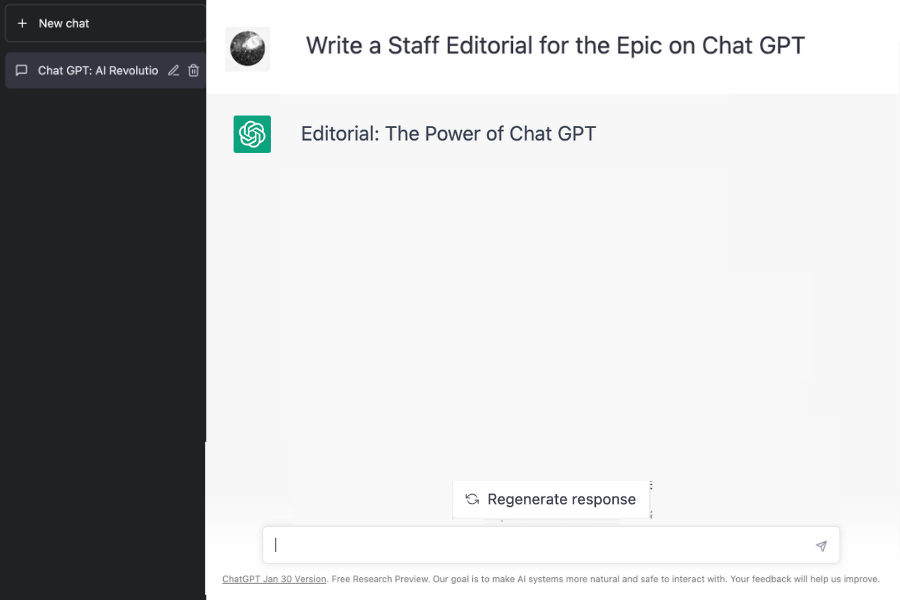Editorial: A controversial chat on ChatGPT
Screenshot by Meera Nambiar from the ChatGPT website
ChatGPT is an AI chatbot capable of generating humanlike text, working computer code and more in a wide range of styles and lengths.
February 6, 2023
As the popularity of artificial intelligence chatbots has risen, so too have concerns surrounding the ethics and risks of AI’s presence in educational environments. Created by OpenAI, an artificial intelligence research nonprofit, ChatGPT is an AI chatbot capable of generating humanlike text, working computer code and more in a wide range of styles and lengths. The possibilities are seemingly endless — as are the ethical concerns that have plagued the platform since its launch in November 2022. For classrooms in particular, ChatGPT’s implications require both students and teachers to learn to utilize it as an educational tool, working with and not against the technology.
The main concern has been the potential for academic dishonesty as programs like ChatGPT become increasingly popular. With a simple interface and responses capable of slipping past plagiarism checkers, ChatGPT is not the first AI tool to help students seek shortcuts, but is currently one of the most sophisticated and accessible.
“As we find that plagiarism tools get better at detection, we will be able to integrate ChatGPT in classrooms,” FUHSD Coordinator of Educational Technology Menko Johnson said. “But currently, we just can’t overlook the elephant in the room.”
With student dishonesty in the face of academic pressure being an ever-present issue, some educators have reevaluated their teaching methods. For instance, in lieu of at-home essays, teachers are considering more in-class timed writings or varying prompts. Similarly, teachers have adjusted the weight of assignments and tests in gradebooks to reflect the risks of asynchronous work, hoping to dissuade students from taking shortcuts with ChatGPT.
“There is such a thing as being a bad test taker, and those students are really going to suffer as some teachers may elect to raise the weight of their test category over time,” history teacher Luca Signore said. “Even the people who aren’t using ChatGPT to cheat will have to deal with that consequence.”
Programs designed specifically for detecting the usage of AI chatbots have advanced alongside their counterparts as well, worked on not only by Silicon Valley giants such as Microsoft and Google, but also by independent developers. One such example is GPTZero, a software created by Princeton University senior Edward Tian. While not flawless, it is currently one of the most popular and effective means of detecting ChatGPT. Turnitin has also been working on integrating an AI detection system into its platform. In this cycle of advancement, the landscape of AI has fallen into an arms race where neither chatbots nor detectors hold the advantage for long.
Across the nation, talks of outright bans of ChatGPT in schools have arisen but have seen little success. Banning use of AI chatbots entirely is not the answer — not if larger issues are to be tackled.
“I think blocking these sites altogether would miss the point,” English teacher Erin Levin said. “Why would I use my mental energy on trying to catch that on the backend? I would rather have that conversation on the frontend with students.”
With the emergence of resources like ChatGPT, it is up to students to consider their own integrity and priorities regarding schoolwork. Educators can adjust their own methods, but students are responsible for policing themselves. However, while it is important to warn students of the risks of setting themselves up for failure by using ChatGPT as a crutch, its potential uses as a constructive educational tool should also be considered.
“As we continue to learn how to navigate this new technology, we’ll find ways to make sure it’s helping and not hurting students in their learning process,” English teacher Anna Kirsh said. “But at the end of the day, it’s just a tool, and any tool has to be taught how to use correctly.”
ChatGPT can be versatile and valuable in the classroom. Many believe it will become the new go-to search engine, with personalized responses and explanations to specific prompts or summaries of complex topics. It may even have applications for some teachers, assisting with creating questions or discussion points. True to its name, ChatGPT can serve as a conversant for students improving their literacy in foreign languages or a sparring partner for practicing debaters.
“There is a kind of an obsession with originality amongst some English teachers, which is unrealistic, both practically and philosophically,” English teacher David Clarke said. “What I’m more interested in is how students put together the information they have and higher order synthetic thinking.”
Even considering all its positive applications, ChatGPT is far from flawless. The software lacks the sophistication necessary to detect biases or misinformation in the data it pulls from the web, sometimes resulting in misleading or factually inaccurate responses — a downfall shared by any other online resource. Its replies to certain prompts also tend to become repetitive or generic.
“The further you get into schooling, the more intricate and detailed the work is, so the less ChatGPT can help out,” Vazirani said. “There are so many limitations.”
While helpful as a simple tool, ChatGPT’s replies are a bland collage of ideas, an algorithm’s imitation of eloquence devoid of the nuance, passion and detail that characterizes human-produced work. At the end of the day, that is what ChatGPT should be: a tool, not a substitute for human creativity.
“As a teacher, I care very much about the emotional authenticity and the integrity of something you’re writing,” Levin said. “I’m excited about the opportunity that ChatGPT presents to revolutionize how teachers think about teaching, but more importantly, how students have to buy into what they’re doing.”
*the Epic voted 40-0 in favor of this stance.*



























































